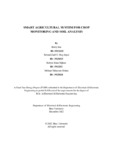| dc.contributor.advisor | Mohsin, Dr. Abu S.M. | |
| dc.contributor.author | Das, Bristy | |
| dc.contributor.author | Ul Hoq Sayor, Tahmid Zarif | |
| dc.contributor.author | Nijhum, Rubyat Jahan | |
| dc.contributor.author | Tishun, Mehnaz Tabassum | |
| dc.date.accessioned | 2024-02-19T06:03:40Z | |
| dc.date.available | 2024-02-19T06:03:40Z | |
| dc.date.copyright | 2022 | |
| dc.date.issued | 2022-12 | |
| dc.identifier.other | ID: 19121123 | |
| dc.identifier.other | ID: 19121015 | |
| dc.identifier.other | ID: 19121111 | |
| dc.identifier.other | ID: 19121024 | |
| dc.identifier.uri | http://hdl.handle.net/10361/22439 | |
| dc.description | This final year design project is submitted in partial fulfillment of the requirements for the degree of Bachelor of Science in Electrical and Electronic Engineering, 2022. | en_US |
| dc.description | Cataloged from PDF version of final year design project. | |
| dc.description | Includes bibliographical references (pages 115-116). | |
| dc.description.abstract | Agriculture is the base of the economy in Bangladesh, however, 90% of the farmers are not
familiar with modern-technological tools. That is the reason why we see very-little usage of
modern tools in farming in our country which limits crop production significantly.
Hence to address this, a smart monitoring system is proposed to introduce farming robots to
bring a strong revolution to the existing primitive systems. The proposed system will include
a range of sensors, including cameras and probes, to detect ripe vegetables and harvest them,
as well as analyze soil conditions and provide advice to farmers. The system will use image
processing techniques and an NPK sensor.
The primary objectives of the project are to reduce labor requirements and improve the
efficiency of agricultural production. Advancements in technology will enable modern farms
and agricultural businesses to utilize cutting-edge tools, robotic systems, and precision
farming methods to become more successful, productive, safe, and environment friendly.
Automated navigation and harvesting, crop growth monitoring, and crop disease detection
can be achieved through the use of sensors, robotic arms, and machine learning algorithms,
respectively. However, these advancements require sufficient data to train the machine
learning models, making them a long-term goal for the future. | en_US |
| dc.description.statementofresponsibility | Bristy Das | |
| dc.description.statementofresponsibility | Tahmid Zarif Ul Hoq Sayor | |
| dc.description.statementofresponsibility | Rubyat Jahan Nijhum | |
| dc.description.statementofresponsibility | Mehnaz Tabassum Tishun | |
| dc.format.extent | 140 pages | |
| dc.language.iso | en | en_US |
| dc.publisher | Brac University | en_US |
| dc.rights | Brac University project reports are protected by copyright. They may be viewed from this source for any purpose, but reproduction or distribution in any format is prohibited without written permission. | |
| dc.subject | Rover | en_US |
| dc.subject | NPK sensor | en_US |
| dc.subject | Inverse kinematics | en_US |
| dc.subject | Robotic arm | en_US |
| dc.subject | Harvesting | en_US |
| dc.subject | Soil analysis | en_US |
| dc.subject | Tomato | en_US |
| dc.subject | Image processing | en_US |
| dc.subject | Ripe | en_US |
| dc.subject | Navigation | en_US |
| dc.subject.lcsh | Agricultural innovations. | |
| dc.subject.lcsh | Agriculture--Automation. | |
| dc.title | Smart agricultural system for crop monitoring and soil analysis | en_US |
| dc.type | Project report | en_US |
| dc.contributor.department | Department of Electrical and Electronic Engineering, Brac University | |
| dc.description.degree | B. Electrical and Electronic Engineering | |

